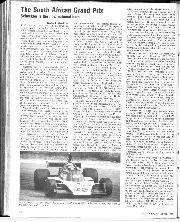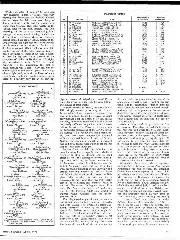Carlos had older brothers who were happy to help his dad in the family business, so there was less pressure for the younger Pace to follow suit. He dutifully studied accounting, but as a teenager was able to devote most of his time to karting, a passion fostered by childhood friend Wilson Fittipaldi and his kid brother Emerson.
Carlos first raced a kart in 1960, and soon became part of a close-knit Brazilian motor racing ‘family’ which encompassed the country’s current F1 stars. Central to the scene were of course the Fittipaldis, while also in action in the ’60s were the father and uncle of Pedro Diniz, and the Giaffone family, who can count Rubens Barrichello as an in-law.
With Wilson’s encouragement, Carlos made the move to cars in 1963. Over the next few years Pace raced DKWs, Alpines, BMWs and Alfas, and gained some early single-seater experience when Formula Vee came to Brazil. The fastest car he drove was an ex-works Alfa T33/3 2-litre prototype. Three times a national champion, Carlos had only one way to progress – by going to Europe.
Wilson tasted the water without success in 1966, but the first driver to really make the move overseas was Emerson, in 1969. Pace followed a year later, and soon made his name in the cut-and-thrust of British F3, winning races and eventually taking the Forward Trust title. That year he also married Elda, his girlfriend of 10 years.
“He came back to Brazil and his father was having problems with the business,” says Gancia, “and he wasn’t sure he could return to Europe. That’s why he had a very late start in 1971. We had some sponsorship from a bank and showed up at Thruxton and talked to Max Mosley, Ron Dennis and Frank Williams. We decided to go for Frank — Carlos liked him. But by the time Crystal Palace came up, Frank still didn’t have a car, so we had to con him…”
A friend of Carlos pretended to be an irate representative of the bank, and a ruffled Williams soon found a chassis. Pace duly made quite an impact on his debut, and later he would win at Imola.
Frank has always rated Pace as one of his favourite drivers: “He was a very pleasant person, but tough-minded. He was physically very strong, with an Alan Jones sort of build. He played a lot of tennis and swam and so on, but I tried to get him to go running in Hyde Park, and he turned up a few times. But a bit like Jonesie, he just wasn’t built for it”
In 1972 Carlos moved straight into F1 with Williams, driving a March 711 for what Gancia claims was just £11,200 of sponsorship for the season. Quicker than team-mate Henri Pescarolo, he finished 10th on his debut at Kyalami, and delighted Frank by finishing sixth next time out at Jarama. But there were no celebrations.
“On Friday they called us and said that Carlos’ father had committed suicide,” says Gancia. “It was linked to business and a very unfortunate brother that Carlos had. We decided to say nothing to him, and after the race Wilson Fittipaldi Sr, Emerson’s father, was the person to convey the news to him. We had already organised a flight for him to go back to Brazil. Carlos was the dearest son of his father, and he loved his father more than anything. They were very close.”
Putting the tragedy behind him, Carlos regularly qualified just outside the top 10, and added a fifth place in Belgium, although the 711 was past its best.
“Remember he was driving for a team with no technical knowledge whatsoever,” admits Williams, “and even less money than technical knowledge. We got from one crisis to the next. I wouldn’t say his career was well served by us apart from putting him in F1, but he did some very good races in mediocre equipment. He was a very smooth driver and very quick in fast corners.”
Before the end of the year he switched camps to Surtees, making his debut in the Victory Race at Brands in October, where he finished a fine second. The ’73 season began with a series of unfortunate retirements and endless pit stops to replace worn out Firestones, but in August he finished fourth at the Nürburgring and third at the Österreichring — setting fastest lap on both occasions. Carlos excelled on the most challenging circuits, and a sportscar contract with Ferrari enabled him to sample Spa, where he stunned Jacky Ickx with his instant speed.
Taking over as Surtees team leader in ’74, he began the year with a fourth place at Interlagos before realising that, as at Williams, he wasn’t getting anywhere. In the middle of the season he accepted an offer from Bernie Ecclestone and joined namesake Carlos Reutemann at Brabham. Reutemann held the advantage at first, but Pace nearly won in Austria. At Monza he qualified third and set fastest lap, although a pit stop left him down in fifth. His luck improved at the US GP, where he finished second to Reutemann, again with a fastest lap. That may or may not have had something to do with a redesign of his famous helmet.
“Carlos had the arrow pointing down,” says Gancia, “I’m not superstitious, but a lady told me an arrow pointing down does not indicate good vibes, and when I went to the US GP with him we changed it around…”

Pace struggled with woeful Alfa-powered Brabham in ’76
Grand Prix Photo
In 1975 Pace was on great form with Gordon Murray’s Brabham BT44B, immediately scoring that memorable debut win on home ground at Interlagos after Jean-Pierre Jarier’s Shadow expired. He followed that with pole (and yet another fastest lap) at Kyalami, but while he often qualified well, decent finishes were rarer.
He then struggled through 1976 with the unwieldy and woefully unreliable Brabham-Alfa, making the points on just three occasions. Reutemann jumped shipped to Ferrari even before the season ended, but Pace had kept the faith.
“The thing I really remember is the Alfa engine, which was a disaster,” says Bernie today. “When the car stopped early – we always had an early flight booked – he used to hop over the wall and say, ‘That’s it, it’s the last race, I’m going back to Brazil, I’m finished with F1, I don’t want to have anything to do with it.’ By the time we got in the hire car he’d start discussing what he thought the problem was, and then when we got in the plane it was, ‘We must go to Alfa and check what’s going on’. By the time I dropped him at his house he was looking forward to the next race. Typical. Carlos. He was a very positive person.”
The 1977 car was a far better proposition, and after winter testing Pace even hinted that the title was a possibility. He led the opening race in Argentina, but dropped back to second when intense heat in the cockpit left him dehydrated. He led again at his home race in Brazil, before tangling with James Hunt, and then qualified a promising second in South Africa, although in the race he made a bad start and slipped down the field after a tyre stop. The new car was clearly very competitive, and when Pace headed home to Brazil, he was convinced that a win wasn’t far away.






